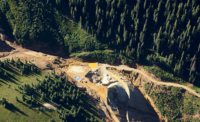
As the fallout from the Animas Mine blowout continues, the U.S. Environmental Protection Agency is under fire as criticism mounts regarding the agency's handling of the Aug. 5 spill that spewed 3 million gallons of mine wastewater into Colorado's Animas River.
Congressional hearings are scheduled for early September, and House Science and Technology Committee Chairman Lamar Smith (R) on Aug. 25 put out a statement complaining that the agency is not cooperating sufficiently with the committee's investigation into the incident.
EPA has conducted an investigation of its own and largely taken responsibility for what happened. In a report released on Aug. 24, EPA concluded, based on its own internal audit, that the blow was likely "inevitable" because of geological conditions at the site, which is in a remote, rugged area in the Rocky Mountains.
EPA said the team removing waste at the Gold King Mine was "quite experienced and followed standard procedures of a well-thought-out work plan." Environmental Restoration was the contractor on-site at the time and has referred all media inquiries to EPA. The agency noted, however, that the team underestimated the water pressure in the Gold King Mine, which was likely the cause of the blowout.
EPA said it should develop guidance to outline the steps that should be undertaken to minimize risk of an adit blowout related to an investigation or cleanup activities. Moreover, additional methods for testing should be available, such as remote sensing, to give teams more certainty about water pressures.
Also, better emergency action and contingency planning should be required on similar projects, EPA concluded.
Lawmakers are not the only people criticizing the EPA. Bill Simon of the Animas River Stakeholders Group, which represents a wide variety of businesses and residents in the area, says it would have liked more input into EPA's activities at the Gold King Mine before the blowout. "I think they acted prematurely," he says. "I don't think everything was in place to open the portal."
Further, the public is frustrated with the lack of sampling and testing information being released by EPA on the safety of Animas River water for human needs. "I think the water quality is safe now, but that is only from this one spill," says Simon. "EPA hasn't really set out the risk factors related to the ongoing accumulation of sediment-scum-on the riverbed because I don't think they know how to. Sediment is what the public is real concerned about."
Navajo tribes, for instance, are concerned about using water from the Animas for irrigation and livestock needs. "The primary thing that EPA needs to do in the coming weeks is [to] satisfy the minds of the various water users that it's safe, and if it's not, then we need to know exactly what isn't safe about it. For now, I don't think we have adequate information."
Peter Butler, a member of the stakeholder group, said that, despite the group's criticism of the EPA's timeliness and lack of preparedness, it wanted to move forward and continue working with the agency in the future for change in the area.
But Gold King Mine owner Todd Hennis says the EPA remains ill-prepared to handle the challenges of the mountain. "They need to admit that the core problem is the bulkheading of the Sunnyside mine, and that the only solution is to dewater the Sunnyside mine to a safe level and treat the water," he says. The Sunnyside Gold company operated one of the longest-running gold mines in the area but was allowed via a court settlement to walk away from reclamation responsibilities in the 1990s.
Hennis fears another spill could go into the billions of gallons. "That's because the bulkheading of the Sunnyside mine was a complete failure. A seismic event or just build-up of hydrostatic pressure in the mine could destroy the bulkhead, and then we would be looking at another, much worse disaster."
The EPA has taken control of a shuttered water treatment plant operated by Sunnyside Gold, but much needs to be done to return it to operation. The Bureau of Land Management and EPA's inspector general are expected to conduct additional audits of the incident soon.





Post a comment to this article
Report Abusive Comment